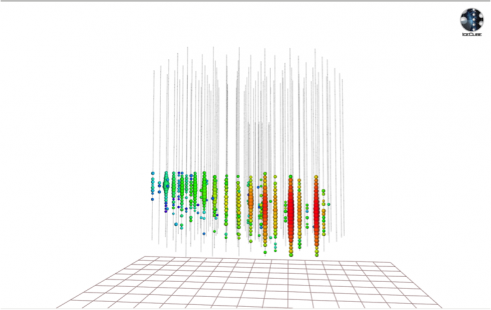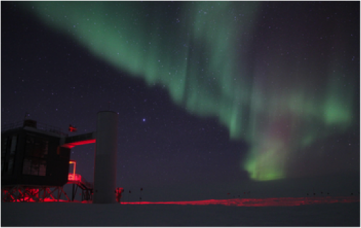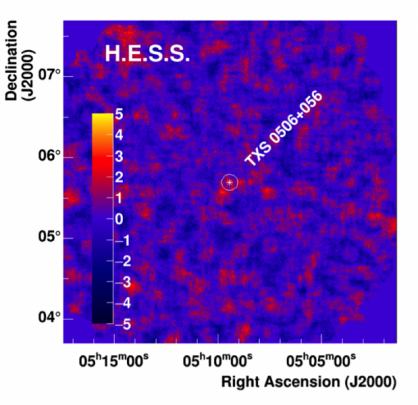The ANTARES and HESS collaborations have followed-up the IceCube observation of a first possible high-energy neutrino source candidate, and the APC groups have had a strong role in these searches.
The IceCube Collaboration has reported, in a press conference at the US National Science Foundation on July 12th 2018, a correlation between high-energy neutrinos and the blazar known as TXS0506+056. This object was first brought to attention following a neutrino alert sent by IceCube on Sept. 22nd 2017 (IC170922A). About 20 observatories on Earth and in space have participated to a large multi- messenger effort to follow-up the alert on their data streams and to search for correlation in archival data. Two papers [1, 2] have been published reporting these results.
messenger effort to follow-up the alert on their data streams and to search for correlation in archival data. Two papers [1, 2] have been published reporting these results.

High-energy neutrino search: ANTARES analyses
The IceCube collaboration shared some restricted information with the ANTARES Collaboration in compliance with a Memorandum of Understanding. Three different searches for neutrino candidates associated with IC170922A or from the direction of TXS 0506+056 were performed by ANTARES:
- The first search refers to the online follow-up associated with IC170922A.
- The second one is based on the standard method employed by the Collaboration to search for a time-integrated directional excess from point-like neutrino sources.
- The third one uses the information from the time-dependent analysis performed by the IceCube Collaboration, which reports a neutrino-bursting activity centered on December 13, 2014, as input for an ANTARES dedicated study.
The results of the searches are presented in a submitted journal article [3]. The online follow-up and the time-dependent analysis yield no events related to the source and to the neutrino flare reported by the IceCube Collaboration . The time-integrated study, performed over 10 years of ANTARES data taking from 2007 to 2017, reports 1.03 fitted signal events from the region around TXS 0506+056, which corresponds to a pre-trial p-value of 3.4%. TXS 0506+056 consequently appears as the third most significant source among the 107 scrutinised by ANTARES for the period 2007-2015. Accounting for all trials, the p-value rises up to 87%.

High-energy gamma-ray search: Observation with HESS
Combined observations of various cosmic messengers might indeed provide the missing pieces of information about the violent phenomena at the origin of high-energy cosmic rays. High-energy gamma rays play an important role in this context. The H.E.S.S. collaboration has been participating in multi-messenger observations for the past several years, in close collaboration with both of the major neutrino telescopes, IceCube and ANTARES.
On September 22, 2017: at 20:54:30.43 Coordinated Universal Time (UTC), a high-energy neutrino of about 290TeV (IceCube-170922A) was detected by the IceCube neutrino telescope. An alert was distributed to observatories around the globe within 1 minute. The direction of the neutrino (reconstructed to an area of about 1sq deg and consistent with the location of a known gamma-ray blazar TXS 0506+056) became visible at the location of the H.E.S.S. observatory in Namibia around 4 hours later and follow-up observations were started (cf. Astronomer Telegram ATEL #10787). Additional observations were obtained on subsequent nights but no gamma-ray emission could be detected from the region. Upper limits at 7.5x10-12 erg / cm2 /s (95% C.L.) on the gamma-ray flux level were subsequently derived.
More information:
The IceCube Collaboration Website: https://icecube.wisc.edu/
The ANTARES Collaboration Website: http://antares.in2p3.fr/
The H.E.S.S. Observatory Website: https://www.mpi-hd.mpg.de/hfm/HESS/
[1] "Multimessenger observations of a flaring blazar coincident with high-energy neutrino IceCube-170922A,” The IceCube, Fermi-LAT, MAGIC, AGILE, ASAS-SN, HAWC, H.E.S.S, INTEGRAL, Kanata, Kiso, Kapteyn, Liverpool telescope, Subaru, Swift/NuSTAR, VERITAS, and VLA/17B-403 teams, Science 361. DOI:10.1126/science.aat1378
[2] "Neutrino emission from the direction of the blazar TXS 0506+056 prior to the IceCube-170922A alert,” IceCube Collaboration: M.G. Aartsen et al. Science 361. DOI:10.1126/science.aat2890
[3] “Search for neutrinos from TXS 0506+056 with the ANTARES telescope”, ANTARES Collaboration: A. Albert et al., https://icecube.wisc.edu/static/docs/submitted_txs.pdf


